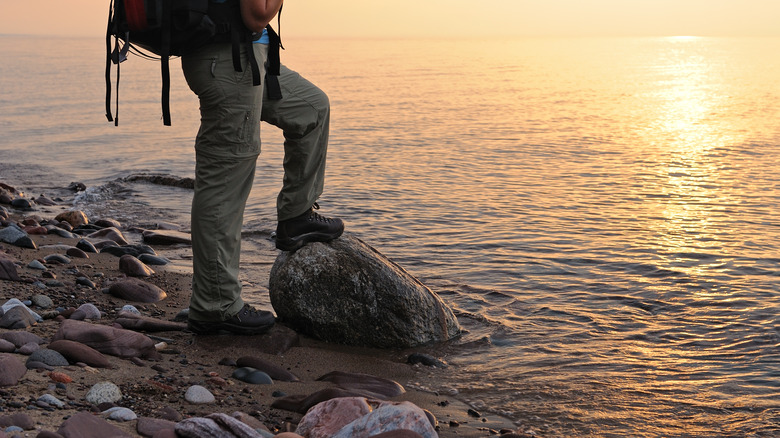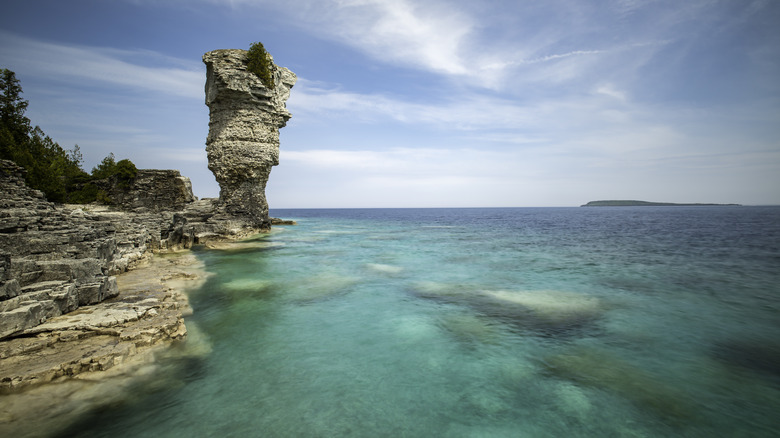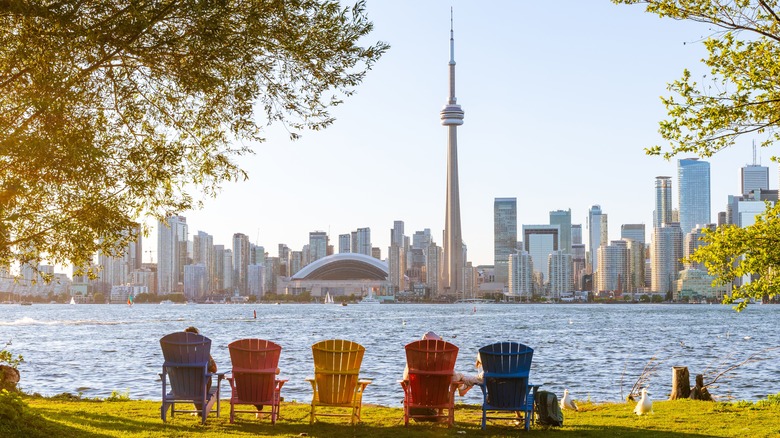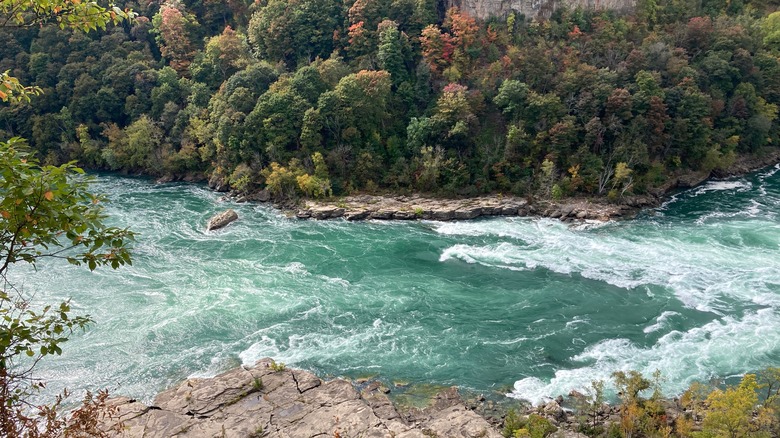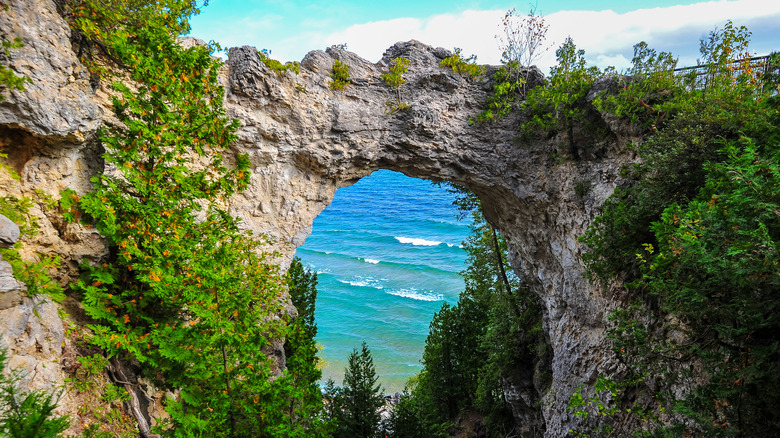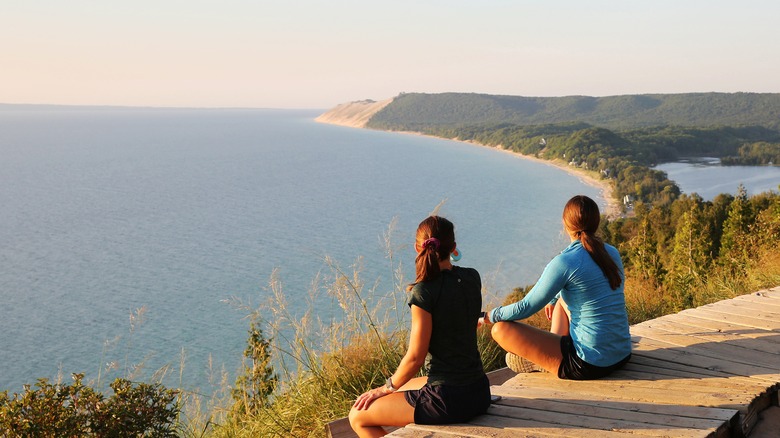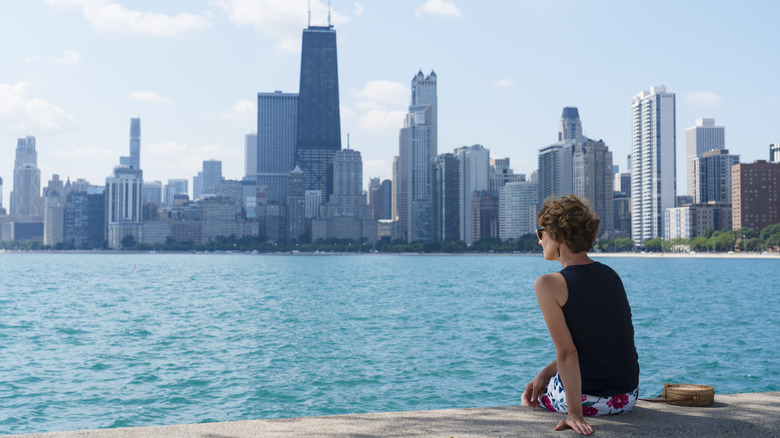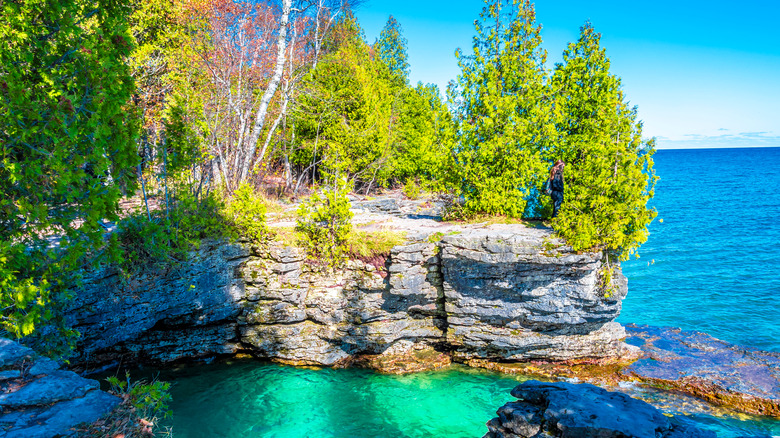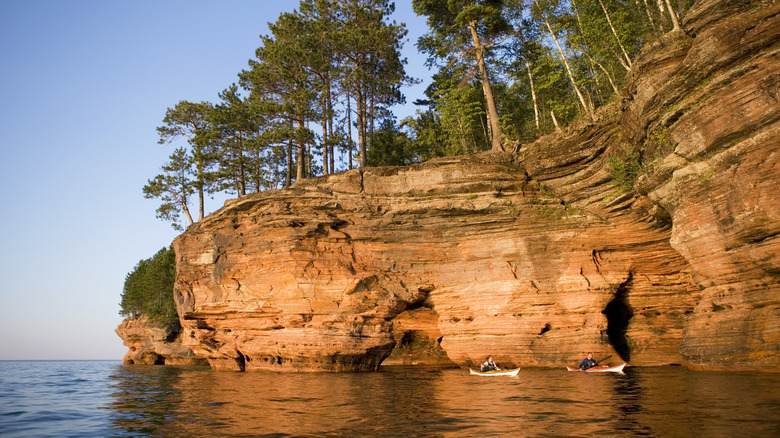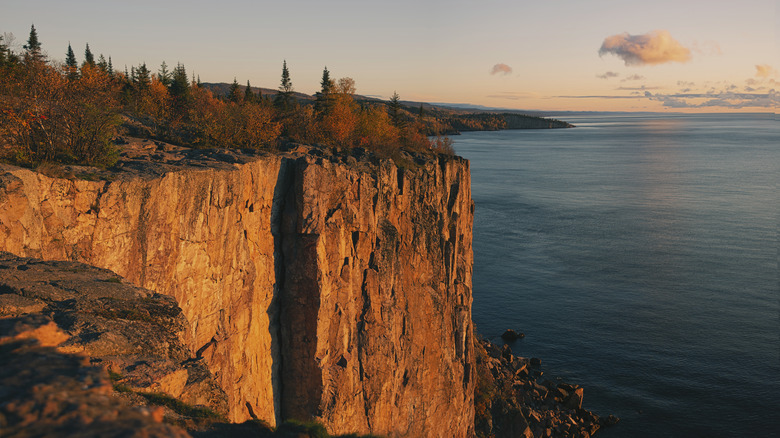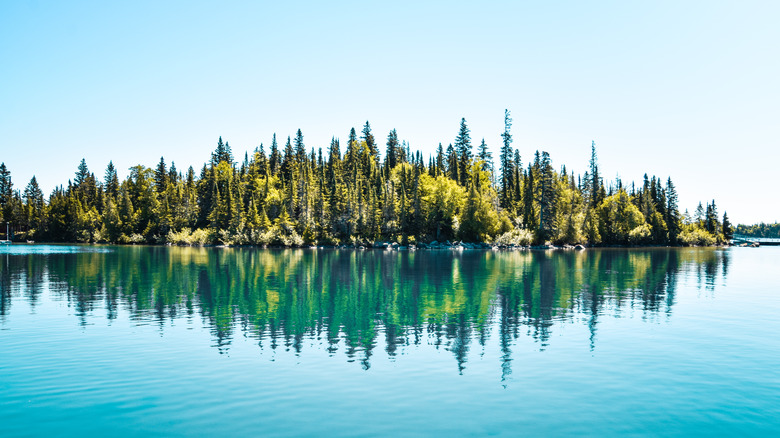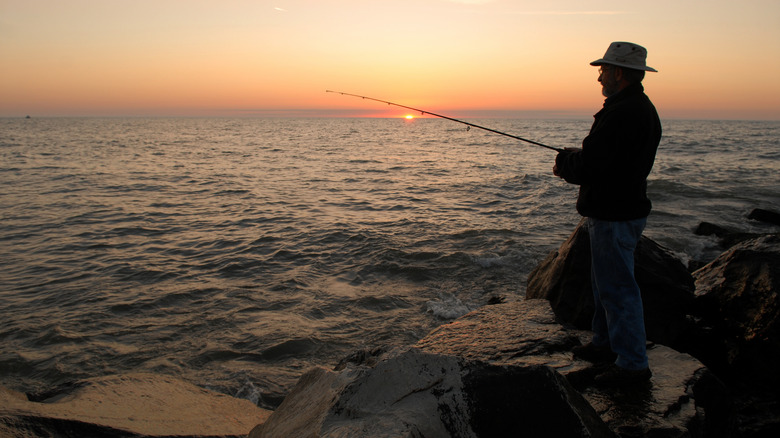The Most Beautiful Hikes That Show Off The Great Lakes, According To Reviews
Many people believe that the United States and Canada have three coasts: the Atlantic, the Pacific, and the Great Lakes. The latter is an assemblage of freshwater lakes in the middle of the continent that, at 94,250 square miles, is the largest collection of freshwater lakes in the world. They also comprise more than 20% of the planet's freshwater. These inland seas offer almost as much diversity of scenery and experience as their oceanic counterparts, from dense forests and fiery sandstone cliffs to thundering waterfalls and booming cities. Traversing all these wonders are thousands of miles of trails, which allow grateful hikers to enjoy these shimmering lakes and all the beauty they enable.
Starting at the unique flowerpots of the Bruce Peninsula, we travel clockwise down to the skyscrapers of Toronto and the roar of Niagara Falls before reaching wholesome and historic Mackinac Island (where an alarming daily ritual might surprise you). We then venture down Lake Michigan to Chicago and up Lake Michigan's west end to the staggering beauty of Michigan's Upper Peninsula and Lake Superior. So, grab your hiking boots, backpack, and wetsuit, and let's go for a walk by the lake.
Flowerpot Island Loop Trail, Ontario
Many of the Great Lakes' greatest hits occur when fantastical rock formations tower over beautiful, bright blue water and dense green forests. We're starting our Great Lakes journey in Lake Huron, next to the two "flower pot" sea stacks that lend their name to Flowerpot Island. This picturesque island, about 4 miles off the coast of western Ontario's stunning Bruce Peninsula, packs a lot into its 0.77 square miles.
First and foremost are the 6- and 12-foot flower pots, which were formed by centuries of wind, rain, and ice chiseling a former cliff into the shape of slender flower pots. These unique formations can be accessed by the 2.1-mile Loop Trail, a fairly easy, well-paved trail that makes its way along the shore of Flowerpot Island. The trail will also take hikers to Beachy Cove, a great spot for swimming in water as turquoise as those for kayaking in the Caribbean. Then, next to a picnic area, a cave, and the picturesque 88-foot lighthouse at the end of the island. More adventurous hikers can venture into the island's forests through the Marl Trail.
If you'd like to spend the night, there are six tent campsites. If not, you can take either of the two ferry services back to the town of Tobermory on Ontario's stunning Bruce Peninsula. Unlike Flowerpot Island, Bruce Peninsula National Park is open for incredible hiking all year round. For another geological wonder, make sure to explore the stunning Grotto sea cave.
Toronto Islands Trail, Ontario
The ferry from downtown Toronto to the Toronto Islands will provide you with quite a different view from the one to Flowerpot Island, 3.5 hours north. Instead of looking at the flowerpots or the dense forests of the Bruce Peninsula, you'll see the gleaming skyline of Canada's largest city, crowned by the CN Tower offering incredible views.
Once you dock, you'll be treated to 15 car-free islands connected by a series of paths and footbridges, which, at 560 acres, is the largest car-free urban community in North America. As the central park of a major world city, Toronto Island Park seamlessly mixes bucolic lakeside charm with a cosmopolitan bustle. The islands boast four beaches perfect for swimming, kayaking, and canoeing; a 30-ride amusement park; an 18-hole golf course; two baseball diamonds; splash pads and playgrounds; scores of restaurants and cafés; a petting zoo, and even a hedge maze made of 1,200 black cedar trees.
The park is large enough to quietly enjoy the woods, ponds, and birds and the breathtaking views of the Toronto skyline. It offers many beautiful trails, but the best is the 9-mile Toronto Islands Trail, which loops around the perimeter. This is mostly paved and accessible to pedestrians, bikes, wheelchairs, and leashed dogs. It's the perfect route to take in all the majesty of the lake, the city, and the island paradise that blends the two so well.
Niagara Gorge Rim Trail, New York
If you like to witness one Great Lake turn into another in spectacular fashion, there's only one place to go: Niagara Falls. Three 188-foot waterfalls comprising 6 million cubic feet of water per second tumble dramatically from the other four Great Lakes into Lake Ontario. Of course, to the rapturous delight of roughly 20 million tourists a year.
There are many exhilarating ways to experience the falls, from boat rides to helicopter tours, but sometimes, the best comes when you really earn it. The Niagara Gorge Rim Trail runs 5.3 miles along the raging rapids of the Niagara Gorge, a long canyon carved by the Niagara River. The trail offers stunning views of the rapids and passes through three state parks, culminating at Goat Island at the top of the falls. The trail begins at Devil's Hole State Park, a 42-acre park overlooking the Class 6 rapids of the gorge. It continues through a beautiful forest to Whirlpool State Park, which offers a recreational space with playgrounds and picnic tables overlooking the Niagara Whirlpool, which can spin as quickly as 30 feet per second. If you're feeling brave, take the Whirlpool Aero Car above the whirlpool.
At the end, cross one of two bridges into Goat Island and stare down in awe at the falls thundering below you. If your feet aren't too tired, hike the Goat Island Scenic Walk, a 1.9-mile loop around the island.
Mackinac Island Outer Loop, Michigan
Another incredible spot at the intersection of two Great Lakes is the resort Mackinac Island. This is a 3.8-square-mile, car-free island that rests in a narrow strait between Michigan's Upper and Lower peninsulas at the intersection of Lake Huron and Lake Michigan. To get a full sense of everything Mackinac has to offer, hike or bike the Mackinac Island Outer Loop, which circles the 8.2-mile perimeter of the island.
Wherever you are, you'll be just steps away from the teal waters of Lake Huron lapping against the shore. The trail includes numerous beaches, including Mission Point, right next to the eponymous resort. There's also a beach at British Landing, where an antique cannonball from the War of 1812 faces the 5-mile Mackinac Bridge, one of the world's longest suspension bridges. You'll undoubtedly marvel at Arch Rock, a 50-foot limestone arch so perfect that it almost looks manmade.
You'll never be too far from either nature or convenience, part of Mackinac's unique magic. For more of the former, hike inland through one of the island's over 70 trails into beautiful, dense forests. For the latter, head into the picture-perfect downtown brimming with classic Victorian architecture and the clip-clopping of horse-drawn carriages. Mackinac Island is particularly renowned for its fudge, and many of the downtown's 13 fudge shops let you watch the intricate creation process. Equally iconic is the stately Grand Hotel, famous for its afternoon tea and 660-foot-wide columned porch, the longest in the world.
Empire Bluff Trail, Michigan
About 130 miles southwest of Mackinac, the aptly-named Empire Bluff Trail sits atop majestic bluffs that tower 450 feet over Lake Michigan. It blesses hikers with near panoramic views of miles of pristine lakeshore. The dramatic vista of a forested coastline and white bluffs curving gracefully around bright blue waters are why the Sleeping Bear Dunes National Lakeshore was named "Most Beautiful Place in America" by Good Morning America in 2011.
The Empire Bluff Trail is a 1.5-mile, hilly loop through a portion of this protected lakeshore that takes hikers through fields, beech-maple forest, and the high dunes that offer such vaunted views. However, this picturesque loop is just one of several attractions of the 105-square-mile Sleeping Bear Dunes and the Leelanau Peninsula on Michigan's northwest coast. For more outstanding sights, head to Pyramid Point, which towers 300 feet above Lake Michigan and has become a popular hang-gliding spot due to its high winds.
Climbers will also enjoy the Dune Climb, a strenuous hike up 284 feet of glistening white sand. Immediately adjacent to the Dune Climb are the turquoise waters of Glen Lake, named the fifth most beautiful lake in the world by National Geographic. To enjoy rugged, unspoiled wilderness, take the ferries to either North or South Manitou Island — great spots for camping, hiking, and diving. If your legs are tired, take a leisurely ride through Pierce Stocking Scenic Drive, which affords beautiful vistas of lake, forest, and a lovely Vermont-style covered bridge.
Lakefront Trail, Chicago
For quite a much livelier stroll, consider Chicago's dynamic, bustling, beautiful Lakefront Trail. It runs 18 miles along Lake Michigan, one of the most famous shorelines in the world, through 24 beaches and many of the best attractions of this world-famous city. The trail, which is divided into separate bike and pedestrian sections, starts at the South Shore Cultural Center on the South Side. It continues north to Jackson Park, which once hosted the famous 1893 World's Columbian Exposition and will soon house the Barack Obama Presidential Center. Then, to Promontory Point, a peninsula that will offer the first views of Chicago's jaw-dropping skyline. Eventually, the trail reaches Museum Campus, a 57-acre lakeside park part of the larger Grant Park.
As its name suggests, the Museum Campus is home to the Adler Planetarium, the Shedd Aquarium, and the Field Museum of Natural History. Grant Park continues into the heart of downtown Chicago. Sandwiched in between Lake Michigan and a sea of majestic skyscrapers are iconic attractions like the Buckingham Memorial Fountain, the Art Institute of Chicago, and Millennium Park, home to the Jay Pritzker Pavilion and the famous Cloud Gate sculpture, more commonly known as "The Bean." Continuing north, you'll hit the famous Navy Pier, home to over 50 acres of shops, restaurants, parks, and more. The Lakefront Trail continues to North Avenue Beach, the Lincoln Park Zoo, and ends at Kathy Osterman Beach.
Cave Point Lakeside Trail, Wisconsin
Generally, any jagged peninsula jutting out into water is going to be incredibly beautiful. That's true for the Bruce Peninsula in Ontario, the Leelanau Peninsula in Michigan, and Door County in Wisconsin. The latter is a lakeside peninsula about four hours north of Chicago that is often called the "Cape Cod of the Midwest."
One of Door County's most celebrated sites is Cave Point County Park, a series of 30-foot cliffs and sea caves towering above the lapping waves of Lake Michigan. The erosion from those waves has created several geological wonders, notably the circular cave, Devil's Cauldron. Cave Point has become an increasingly popular spot for adventurous cliff jumpers and kayakers who like to venture into the eerily green caves. But the waters are often rough and cold, and anyone who prefers to stay warm, dry, and safe will enjoy the many nearby hiking trails. Notably, the Cave Point Lakeside Trail, a 1.6-mile out-and-back loop that hugs the pristine shore leading up to Cave Point.
Other popular nearby trails include the Black Trail, which ventures into the woods and connects to Whitefish Dunes State Park. The park consists of 863 acres of forest, dunes, beaches, picnic areas, and the highest sand dunes in Wisconsin. That beautiful scenery continues throughout Door County, which, in addition to its beautiful forests, dunes, and beaches, is celebrated for its lighthouses, shipwrecks, cherries, vineyards, and quaint towns full of cozy country inns.
Chapel Loop, Pictured Rocks, Michigan
The Pictured Rocks National Lakeshore, an exquisite 42-mile stretch of sandstone cliffs along Michigan's Upper Peninsula, almost looks as though someone picked up a chunk of Utah's impeccable natural beauty and stuck it along Lake Superior. One of the best trails to experience the blazing red, thrillingly unique rock formations, caves, cliffs, and arches is the Chapel Basin Loop. This is a 10.4-mile loop that passes some of the park's most exquisite attractions. The loop hugs the lakeside cliffs and travels inland so that hikers can experience a beautiful forest containing two waterfalls.
Starting clockwise from the trailhead, you'll hike through dense woods to Mosquito Falls, a tranquil forest waterfall. You'll continue to Mosquito Beach, a nice sandy waterhole perfect for a bit of relaxation before you head up the cliffs. The trail then ascends up the iconic Pictured Rocks, stopping first at Arch Rock, one of the park's many iconic sea arches looping gracefully over the lake. It continues to the massive Indian Head Rock arch, and to the iconic Grand Portal Point, arguably the most recognizable, photographed sea arch of Pictured Rocks.
Close to its end, the trail continues through Battleship Row, an immediate succession of three dramatic cliffs. Then, to Chapel Beach, another sandy beach, and Chapel Rock, a single tree perched fascinatingly atop a gnarled, towering sandstone rock formation. We then head inland through a beautiful forest to Chapel Falls, a 60-foot waterfall flowing down a sandstone gorge into Chapel Lake.
Lakeshore Trail, Apostle Islands, Wisconsin
For more jaw-dropping "Utah meets Lake Superior" scenery, head a little over 5 hours west along the Upper Peninsula. You will arrive at Apostle Islands National Lakeshore, popularly known as the "Crown Jewels of Lake Superior" for mesmerizing gems. These include dazzling sandstone sea caves, towering cliffs, and 21 pristine islands dotted with more lighthouses than any other U.S. National Park.
There are a total of 50 miles of trails along the various islands, which can be accessed by private boat and kayaking tours, which we highly recommend. The only trail on the mainland is the Lakeshore Trail, an incredible 6-mile stretch along beaches, sandstone cliffs, forests, and one of the park's most treasured attractions: the incomparable sea caves, a collection of red arches towering over the lake. The trail begins at the parking lot to Meyers Beach, a sandy beach with a kayak launch. While the Lakeshore Trail runs above the caves and offers some great views, the best way to experience their full ethereal majesty is to paddle right under the majestic arches. In the winter, one of the Apostle Islands' best hiking trails is the solidly frozen Lake Superior, which leads to bewitching ice caves adorned with a symphony of crystalline icicles.
About 100 feet above the caves, the Lakeshore Trail meanders through a dense forest and streams. The result is beautiful views of lake, cliffs, forest, streams, and caves, a reward for persevering hikers. Eventually, it ends at a reservable campsite.
Shovel Point Trail, Minnesota
It's hard to go wrong just about anywhere on Minnesota's epic Superior Hiking Trail, which hugs its 296-mile Lake Superior shoreline from Jay Crooke State Park near Duluth to the Canadian border. This undoubtedly superior trail winds through a breathtaking forest, cliffs, streams, and waterfalls and usually takes a total of two to four weeks to complete.
We heartily recommend the full trail to experienced hikers. Everyone else should consider driving the length of Highway 61, also known as the North Shore All-American Scenic Drive. But for those interested in a day hike along the trail that showcases the splendor of the rugged Lake Superior shoreline, head to the beautiful Tettegouche State Park, an hour's drive north of Duluth, the underrated city on Lake Superior's shores.
Tettegouche is home to both Shovel Point and Palisade Head, two spectacular rock cliffs that tower above Lake Superior. At the top of both of these cliffs, hikers will be rewarded with panoramic views of miles and miles of forest that eventually meet a jagged, rocky shoreline. To reach Shovel Point, hike the relatively straightforward 1.2-mile Shovel Point Trail, which starts in a parking lot off Highway 61 and travels through the lakeside forest until the dramatic Shovel Point overlook. The hike to Palisade Head, about a mile south, is a 0.9-mile out-and-back trail. The park hosts two campgrounds, which are perfect for hikers still interested in making their way along the Baptism River to the park's two incredible waterfalls.
Stoll Trail, Isle Royale, Michigan
We end our journey through the Great Lakes deep in the middle of them, on a huge, remote island archipelago with no permanent inhabitants except for its famous otters, wolves, beavers, and birds. Isle Royale National Park is an 850-square-mile archipelago of over 450 islands and 165 miles of trails. It features resplendent evergreen scenery, but because it is only accessible by expensive boats or seaplanes and has no paved roads or cars, it ranks as one of the country's least visited national parks.
That's great news for the moose, wolves, and hikers looking for a quiet, unspoiled lakeside paradise. One of the prettiest lakeside strolls is the Albert Stoll Memorial Trail, a 4.2-mile loop around a narrow isthmus at the far northern end of the park's main island. The trail travels along two different harbors — one wooded and the other rocky — and culminates at Scoville Point, where hikers can gaze from a rocky ledge into a great blue expanse beyond, dotted with tiny, forested islands.
After returning to the start of the loop at Rock Harbor, home to a gorgeous old lighthouse, ambitious hikers should try at least some of the 21-mile Rock Harbor Trail. This path hugs the main island's beautiful southern coast, splitting off into the 40-mile, mountainous Greenstone Ridge Trail that forms the main island's central spine. For exceptional lake and island views, hike the nearby Louise Lookout Trail, which rewards hikers with a near-panoramic expanse of blue and green.
Methodology
"Beauty is in the eye of the beholder," the saying goes. As we considered this list, we tried to incorporate a diverse range of scenic experiences that captured the very best of this enchanting region, whether they feature sea arches or the CN Tower. We read numerous hiking blogs and reviews and studied the map to find lakeside trails that offered exquisite natural beauty, vibrant urban charm, quaint small-town scenery, or any combination thereof. The common denominator is always those greatest of lakes, our Third Coast, those exquisite turquoise melted glaciers that breathe so much life into our landmass.
